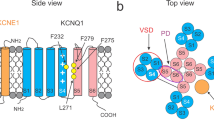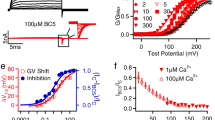Abstract
Large conductance, Ca2+- and voltage-activated K+ channels (BK) respond to two distinct physiological signals—membrane voltage and cytosolic Ca2+ (refs 1, 2). Channel opening is regulated by changes in Ca2+ concentration spanning 0.5 µM to 50 mM (refs 2–5), a range of Ca2+ sensitivity unusual among Ca2+-regulated proteins. Although voltage regulation arises from mechanisms shared with other voltage-gated channels6,7,8, the mechanisms of Ca2+ regulation remain largely unknown. One potential Ca2+-regulatory site, termed the ‘Ca2+ bowl’, has been located to the large cytosolic carboxy terminus9,10,11. Here we show that a second region of the C terminus, the RCK domain (regulator of conductance for K+ (ref. 12)), contains residues that define two additional regulatory effects of divalent cations. One site, together with the Ca2+ bowl, accounts for all physiological regulation of BK channels by Ca2+; the other site contributes to effects of millimolar divalent cations that may mediate physiological regulation by cytosolic Mg2+ (refs 5, 13). Independent regulation by multiple sites explains the large concentration range over which BK channels are regulated by Ca2+. This allows BK channels to serve a variety of physiological roles contingent on the Ca2+ concentration to which the channels are exposed14,15.
This is a preview of subscription content, access via your institution
Access options
Subscribe to this journal
Receive 51 print issues and online access
$199.00 per year
only $3.90 per issue
Buy this article
- Purchase on Springer Link
- Instant access to full article PDF
Prices may be subject to local taxes which are calculated during checkout




Similar content being viewed by others
References
Barrett, J. N., Magleby, K. L. & Pallotta, B. S. Properties of single calcium-activated potassium channels in cultured rat muscle. J. Physiol. (Lond.) 331, 211–230 (1982)
Moczydlowski, E. & Latorre, R. Gating kinetics of Ca2+-activated K+ channels from rat muscle incorporated into planar lipid bilayers. Evidence for two voltage-dependent Ca2+ binding reactions. J. Gen. Physiol. 82, 511–542 (1983)
Cox, D. H., Cui, J. & Aldrich, R. W. Allosteric gating of a large conductance Ca-activated K+ channel. J. Gen. Physiol. 110, 257–281 (1997)
Cox, D. & Aldrich, R. Role of the β1 subunit in large-conductance Ca2+-activated K+ channel gating energetics. Mechanisms of enhanced Ca2+ sensitivity. J. Gen. Physiol. 116, 411–432 (2000)
Zhang, X., Solaro, C. & Lingle, C. Allosteric regulation of BK channel gating by Ca2+ and Mg2+ through a non-selective, low affinity divalent cation site. J. Gen. Physiol. 118, 607–635 (2001)
Cui, J., Cox, D. H. & Aldrich, R. W. Intrinsic voltage dependence and Ca2+ regulation of mslo large conductance Ca-activated K+ channels. J. Gen. Physiol. 109, 647–673 (1997)
Cui, J. & Aldrich, R. W. Allosteric linkage between voltage and Ca2+-dependent activation of BK-type mslo1 K+ channels. Biochemistry 39, 15612–15619 (2000)
Horrigan, F. T., Cui, J. & Aldrich, R. W. Allosteric voltage gating of potassium channels I. Mslo ionic currents in the absence of Ca2+. J. Gen. Physiol. 114, 277–304 (2002)
Schreiber, M. & Salkoff, L. A novel calcium-sensing domain in the BK channel. Biophys. J. 73, 1355–1363 (1997)
Schreiber, M., Yuan, A. & Salkoff, L. Transplantable sites confer calcium sensitivity to BK channels. Nature Neurosci. 2, 416–421 (1999)
Bian, S., Favre, I. & Moczydlowski, E. Ca2+-binding activity of a COOH-terminal fragment of the Drosophila BK channel involved in Ca2+-dependent activation. Proc. Natl Acad. Sci. USA 98, 4776–4781 (2001)
Jiang, Y., Pico, A., Cadene, M., Chait, B. T. & MacKinnon, R. Structure of the RCK domain from the E. coli K+ channel and demonstration of its presence in the human BK channel. Neuron 29, 593–601 (2001)
Shi, J. & Cui, J. Intracellular Mg2+ enhances the function of BK-type Ca2+-activated K+ channels. J. Gen. Physiol. 118, 589–606 (2001)
Shao, L. R., Halvorsrud, R., Borg-Graham, L. & Storm, J. F. The role of BK-type Ca2+-dependent K+ channels in spike broadening during repetitive firing in rat hippocampal pyramidal cells. J. Physiol. 521(1), 135–146 (1999)
Jones, E. M., Gray-Keller, M. & Fettiplace, R. The role of Ca2+-activated K+ channel spliced variants in the tonotopic organization of the turtle cochlea. J. Physiol. 518, 653–665 (1999)
Adelman, J. P. et al. Calcium-activated potassium channels expressed from cloned complementary DNAs. Neuron 9, 209–216 (1992)
Butler, A., Tsunoda, S., McCobb, D. P., Wei, A. & Salkoff, L. mSlo, a complex mouse gene encoding “maxi” calcium-activated potassium channels. Science 261, 221–224 (1993)
Shen, K. Z. et al. Tetraethylammonium block of Slowpoke calcium-activated potassium channels expressed in Xenopus oocytes: evidence for tetrameric channel formation. Pflugers Arch. 426, 440–445 (1994)
Meera, P., Wallner, M., Song, M. & Toro, L. Large conductance voltage- and calcium-dependent K+ channel, a distinct member of voltage-dependent ion channels with seven N-terminal transmembrane segments (S0-S6), an extracellular N terminus, and an intracellular (S9-S10) C terminus. Proc. Natl Acad. Sci. USA 94, 14066–14071 (1997)
Wei, A., Solaro, C., Lingle, C. & Salkoff, L. Calcium sensitivity of BK-type KCa channels determined by a separable domain. Neuron 13, 671–681 (1994)
Jiang, Y. et al. Crystal structure and mechanism of a calcium-gated potassium channel. Nature 417, 515–522 (2002)
Bellamacina, C. R. The nicotinamide dinucleotide binding motif: a comparison of nucleotide binding proteins. FASEB J. 10, 1257–1269 (1996)
Schreiber, M. et al. Slo3, a novel pH-sensitive K+ channel from mammalian spermatocytes. J. Biol. Chem. 273, 3509–3516 (1998)
Moss, B. L. & Magleby, K. L. Gating and conductance properties of BK channels are modulated by the S9-S10 tail domain of the alpha subunit. A study of mSlo1 and mSlo3 wild-type and chimeric channels. J. Gen. Physiol. 118, 711–734 (2001)
Golowasch, J., Kirkwood, A. & Miller, C. Allosteric effects of Mg2+ on the gating of Ca2+-activated K+ channels from mammalian skeletal muscle. J. Exp. Biol. 124, 5–13 (1986)
Oberhauser, A., Alvarez, O. & Latorre, R. Activation by divalent cations of a Ca2+-activated K+ channel from skeletal muscle membrane. J. Gen. Physiol. 92, 67–86 (1988)
Ferguson, W. B. Competitive Mg2+ block of a large-conductance, Ca2+-activated K+ channel in rat skeletal muscle. Ca2+, Sr2+, and Ni2+ also block. J. Gen. Physiol. 98, 163–181 (1991)
Rothberg, B. S. & Magleby, K. L. Gating kinetics of single large-conductance Ca2+-activated K+ channels in high Ca2+ suggest a two-tiered allosteric gating mechanism. J. Gen. Physiol. 114, 93–124 (1999)
Xia, X. M., Ding, J. P. & Lingle, C. J. Molecular basis for the inactivation of Ca2+- and voltage-dependent BK channels in adrenal chromaffin cells and rat insulinoma tumour cells. J. Neurosci. 19, 5255–5264 (1999)
Lingle, C., Zeng, X.-H., Ding, J.-P. & Xia, X.-M. Inactivation of BK channels mediated by the N-terminus of the β3b auxiliary subunit involves a two-step mechanism: possible separation of binding and blockade. J. Gen. Physiol. 117, 583–605 (2001)
Acknowledgements
We thank the members of our laboratory for encouragement and assistance during this work and L. Lavack for preparation and care of oocytes. We thank J. H. Steinbach, J. Nerbonne and L. Salkoff for discussions and comments on the manuscript. We also thank the Department of Anesthesiology, Washington University School of Medicine, for material support.
Author information
Authors and Affiliations
Corresponding author
Ethics declarations
Competing interests
The authors declare that they have no competing financial interests.
Rights and permissions
About this article
Cite this article
Xia, XM., Zeng, X. & Lingle, C. Multiple regulatory sites in large-conductance calcium-activated potassium channels. Nature 418, 880–884 (2002). https://doi.org/10.1038/nature00956
Received:
Accepted:
Issue Date:
DOI: https://doi.org/10.1038/nature00956
This article is cited by
-
Nuclear BK channels regulate CREB phosphorylation in RAW264.7 macrophages
Pharmacological Reports (2021)
-
Molecular determinants of Ca2+ sensitivity at the intersubunit interface of the BK channel gating ring
Scientific Reports (2018)
-
Preliminary Studies of Acute Cadmium Administration Effects on the Calcium-Activated Potassium (SKCa and BKCa) Channels and Na+/K+-ATPase Activity in Isolated Aortic Rings of Rats
Biological Trace Element Research (2018)
-
Calcium- and voltage-gated BK channels in vascular smooth muscle
Pflügers Archiv - European Journal of Physiology (2018)
-
Structural basis for gating the high-conductance Ca2+-activated K+ channel
Nature (2017)
Comments
By submitting a comment you agree to abide by our Terms and Community Guidelines. If you find something abusive or that does not comply with our terms or guidelines please flag it as inappropriate.



